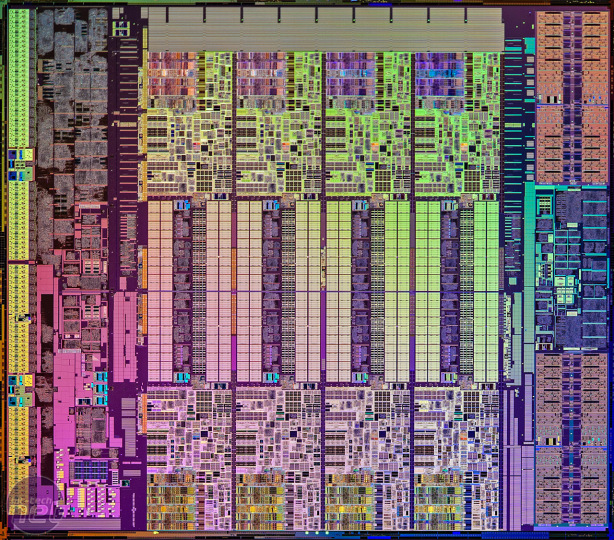Intel Haswell-E; Intel Core i7-5960X Review, X99 Chipset and DDR4
August 29, 2014 | 16:58
Companies: #intel

Overclocking
As we mentioned earlier in this article, the early BIOS we used to get things done in time for the NDA today did result in a few quirks. Turbo Mode appeared to be pretty lacklustre, with the CPUZ reporting the clock speed sitting at 1,200MHz sometimes even when undertaking video encoding benchmarks. Thankfully, later revisions on many of the boards we've looked at so far have fixed this, however there was still the issue of our chosen memory speed - 2,666MHz seemingly forcing the CPU strap to 125MHz. So, to get sensible numbers for the stock speed tests we forced the CPU to it's rated turbo frequency of 3.5GHz using a multiplier of 28.In terms of overclocking the Core i7-5960X, the main issue we ran into was thermal throttling. Coretemp reported the TJmax as being just 87°C and this is quickly breached if you get anywhere near 1.4V, even with an all-in-one liquid cooler - we tried both Corsair's H75 and H105 but it's likely full-on custom liquid cooling is going to be the answer to deal with the heat if you're gunning for maximum overclocks.
We settled on a CPU frequency of 4.45GHz using a x36 multiplier and 123.6MHz baseclock along with a vcore of 1.35V. Here we were bouncing along the redline but it was cool enough for the CPU not to throttle in extended heavy load tests such as Terragen 3.
Click to enlarge
Performance Analysis
To start with, our DDR4 memory speed tests revealed that you'll see only marginal gains in most tests by opting for 3,000MHz DIMMs, albeit all our tests were carried out at the same timings, rather than with different kits and various timings. Even so, our multi-tasking test saw the biggest increase, which is has done on all other platforms too but it's quite difficult to quantify other than a specific test result.
Otherwise the gains were less than 10 per cent and more often than not less than five per cent too. Again, these tests were undertaken with an early BIOS and in the hours leading up to this review being published, we were also aware of new revisions sporting better memory performance. Prices will likely fluctuate over the coming weeks too, so a lot will come down to pricing at any given point in time. At the moment, as with DDR3, 2,400MHz kits appear to cost pretty much the same as 2,133MHz ones unless you go for bargain basement kits.
That's the complicated bit out the way. The easy part is actually digesting the Core i7-5960X numbers and as we suspected, anywhere its eight cores and 16 threads come into play it's astonishingly fast. In the PCMark 8 Photo editing tests it was faster than the Core i7-4790K despite a massive 1GHz clock speed deficit, while in both Cinebench tests it did nothing less than annihilate every other CPU on test with the same difference in Terragen 3 too.
Click to enlarge
However, where the software wasn't quite as multi-threaded and relying more on IPC. then Core i7-5960X struggles. We say struggle - it's still way up there in the charts, but in our somewhat elderly Media Benchmark suite image editing test for example, the Core i7-4970K was much faster, thanks to it offering an additional 1GHz core speed. In fact, we could see the CPU usage languishing in half of the threads in task manager - a clear sign that Hyper-Threading wasn't being used or the software simply couldn't make much use of the additional eight threads.
Turn on the overclocking, though, and the extra speed makes a huge difference. It blasted into first place in many of our tests and the result of 1,747 in Cinebench R15 is nearly 100% faster than the Intel Core i7-4790K and over 40 per cent faster than the overclocked Intel Core i7-4930K. These are huge gains but again, to see it out perform its closest rivals, the software needs to be addressing all 16 threads and putting all of them under heavy load. Our game tests made this clear - not only are they all clearly GPU limited with the CPUs we used, even at our toned-down graphics settings and using a mighty GTX 780, but additional clock speeds resulted in almost negligible gains in performance. It's clear that you'd need to drastically boost the graphics horsepower for any of these CPUs to impact on gaming performance.
Conclusion
As a prelude to our follow-up reviews for the other CPUs,which we're testing as we speak, we can say that they will certainly be better bets than the Core i7-5960X if you're main use for the system will be general tasks such as gaming, web browsing and light rendering or photo and video editing.
The leap from £460 to £760 when this article was published from the Core i7-5930K to the Core i7-5960X is a big one, and we'd much rather put the difference towards an awesome X99 motherboard or additional GPU or both. However, if you're a heavy renderer, or using other programs that regularly make upwards of 90 per cent use of 16 threads, then this is one seriously fast CPU that's quite simply crazy fast once overclocked.

-
Performance48 / 50
-
Features14 / 15
-
Value22 / 35


MSI MPG Velox 100R Chassis Review
October 14 2021 | 15:04










Want to comment? Please log in.